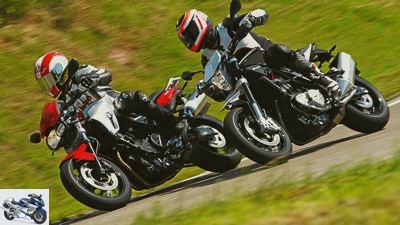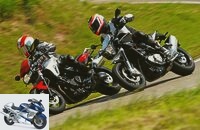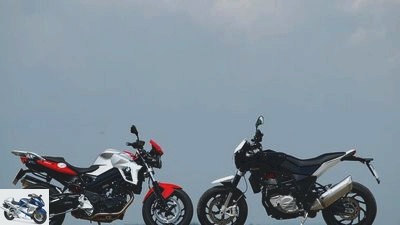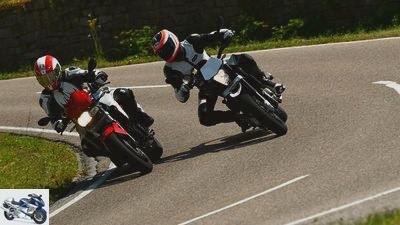Table of contents
- BMW F 800 R and Husqvarna Nuda 900 in a technology comparison So similar the engines are so different their character
- Crank pin offset
- Technical specifications

Gargolov
counselor
technology & future
BMW F 800 R and Husqvarna Nuda 900 – the technology behind it
BMW F 800 R and Husqvarna Nuda 900 in a technology comparison
So similar the engines are so different their character
The scandal is perfect. Not BMW, but Husqvarna is opening a real barrel with the revised F-800 engine. The old trick: an offset crank pin.
Stefan Kaschel
08/30/2012
Sometimes only, very rarely, does a print editor want the technical possibilities of the Internet. Because there are sometimes things that cannot be adequately described in words. The latest example: the start of the joint test drive with the BMW F 800 R and the Husqvarna Nuda. Actually, the incredulous face of MOTORRAD trainee Roman should have been filmed. And save the cause of his amazement as an audio file, because there is no better way to prove how a tiny crank pin offset of a measly 45 degrees (with the corresponding consequences for the ignition timing) can fundamentally change the character of an engine.
Buy complete article

BMW F 800 R and Husqvarna Nuda 900 in technology comparison
So similar the engines are so different their character
6 pages) as PDF
€ 2.00
Buy now
But one after anonther. Surprise number one: the start of the F-800-R parallel twin. Once or twice the starter balances the two 82 millimeter pistons above TDC, and then there it is, the Bayern boxer in an in-line engine guise. Yes, you read that correctly: This in-line two-cylinder, whose crank pins are offset by zero degrees (i.e. rotate in parallel flight around the crankshaft axis and the pistons move up and down at the same time), sounds exactly like a boxer from the same company.
“How can that be”, not only Roman asks himself, “Isn’t a boxer built quite differently?” It is, but that is not important for the sound of an engine. The decisive factor is the ignition interval, which is the same for the Boxer with its 180-degree crank pin offset and for the F-800-Twin. Every 360 degrees, i.e. once per crankshaft rotation, one of the cylinders is in the work cycle (compression and combustion), while the second removes the exhaust gases. It is exactly the same with the boxer, namely with an even ignition interval, except that the crankshaft is parallel to the direction of travel and the cylinders protrude to the right and left of the crankcase. However, the position of the cylinders is not decisive for the sound.
If you can’t believe it, you should try the Nuda start button. Visually the same in-line twin (albeit with more displacement and power and without a red valve cover), but a completely different sound. Hearty V2 grumbling spreads in the underground car park, articulates itself boldly over the tight, narrow exhaust system, gives every throttle an aggressive touch. “V2, definitely V2”, also amazes Roman, does not want to believe it. “And this difference is only made by the crank pin misalignment?”
It is exactly like that. Because the crank pin offset by 45 degrees (which results in the ignition offset of 315 degrees) ultimately imitates a V2 engine in which both connecting rods sit on a crank pin, but the cylinder angle is 45 degrees. Both have the same uneven firing order. First they ignite at a distance of 315 degrees, then 405 degrees in between, then again 315 degrees and so on.
But: The whole thing has little to do with the cozy bubbling of a Harley-Trumm, whose cylinder angle is 45 degrees, because of course there are other factors besides the crank pin offset that have a significant influence on the husky’s sound. On the one hand, there is the exhaust system, which is clearly shorter, narrower and less voluminous, nestling against the rear wheel of the Nuda. More decisive, however, are the extensive additional modifications that turn the Husky twin into a robust sports engine. Two millimeters more bore (84 instead of 82 millimeters) are just as much a part of it as 5.6 millimeters more stroke, the valves one millimeter larger and, above all, the compression that has been increased from 12.1: 1 to 13.1: 1. The bottom line is that the engine, which is a good 100 cubic centimeters larger, has an 18 hp (from 87 to 105 hp) increase in nominal power and a maximum torque of twelve Newton meters (98 Nm at 7000 rpm instead of 86 Nm at 6000 rpm).

Gargolov
Immediately obvious: two completely different interpretations of the parallel twin theme.
These are undoubtedly benchmarks that have an effect on driving operations, especially when they encounter such different framework conditions as in this case. At only 198 kilograms, the long-legged Nuda is not only seven ki-lo lighter than the F 800, but also has a more radical geometry. 25 millimeters less wheelbase, a steering head angle that is half a degree steeper – these values and the significantly more powerful engine result in an explosive mixture, while the twin in the F 800 is more of a good honesty. The amazing thing about it: In the course of the performance cure, the Husky motor has lost nothing, absolutely nothing of its good manners. On the contrary: This in-line two-cylinder is not only compact and powerful, but also easily goes through as one of the best V2s that you can currently buy in terms of power delivery.
Practically from the first crankshaft rotation, it is there, not hacking listlessly on the drive chain in the lower speed range like so many powerful twins, but pushing it forward wonderfully evenly and finely. At the same time, from the 3000 mark onwards, he immediately puts around ten Newton meters between himself and the BMW 800 and maintains this lead, even expanding it. Just like the PS advantage, which is measured at the top is 14 PS, because not only BMW lowers the power specification (94 instead of 87 PS), but also Husqvarna (108 instead of 105 PS). The best thing, however, is that the Husky-Twin holds back even with regard to the vibrations to be feared, although the mass balance should actually be worse because of the crank pin offset. Obviously, the technicians in Varese had a lucky hand with the design of the F-800’s own swivel connecting rod instead of the usual balancer shaft.
What is the BMW engine doing in the meantime? He is in the shadows, in every way. Vibrates more powerfully, falls into a smaller hole at almost 4000 rpm, develops its torque less linearly. And yet it is a formidable all-purpose weapon for all occasions, because its small ailments are only noticeable when the younger brother makes the pace. But before all the satisfied F-800 riders run to the local Husqvarna dealer: stop, stop, this engine fits this motorcycle! The unexcited boxer sound to the relaxed chassis, the relaxed seating position to the manageable range of services, the low consumption (4.1 liters) to the everyday practicality typical of BMW with a relaxed pillion seat and proper luggage storage. Despite its martial appearance, the F 800 R is more of a Biederman than an arsonist, suitable for the majority, as well as when fetching bread rolls and when it comes to alpenglow.
The Husqvarna, on the other hand, is completely different. The wide, almost straight handlebars without any noteworthy cranking automatically put the elbows far outwards, the narrow, uncomfortable (and for smaller people with 890 millimeters too high) seat makes even comfortable drivers fidget around nervously, and the restrained of two selectable injection modes is at best activated once to try it out. Even the civil version of the Husqvarna Nuda without the R addition (Sachs instead of Ohlins strut, no Brembo monoblock saddles) is a first-class lighter. With it you want – yes, you have to – race instead of traveling (which is forbidden anyway with the measly 13-liter tank despite the low consumption of 4.3 liters). If you do it anyway, you will reap a little confidence-inspiring straight-line stability on moderately brisk motorway stages and a brutal excursion into the limiter at full throttle. Incidentally, he also raises a very decisive objection to the brisk country road ride if the driver exaggerates in view of the famous qualities of this engine and leaves the gas too long.
When braking, on the other hand, the Nuda relieves the driver of their own responsibility, and that somehow also fits in with the radical design. ABS is nil, the four-piston calipers from Brembo are toxic, the front with its 210 millimeters of spring travel dips deep. And the Husky, which the majority of all potential two-cylinder fans probably put on their feet – and choose BMW.
Crank pin offset

Gargolov
BMW F 800 R engine: Both pistons reach top dead center at the same time. While one compresses and ignites, the other emits the burned exhaust gases.
The topic is not new, but always exciting: How do I give an existing engine more character or a better sound? An effective means is the crank pin offset.
When we talk about crank pin misalignment today, most people spontaneously think of an example: the Yamaha TRX 850. It was Nippon’s first attack on a bastion that was firmly in Italian hands, because sporty two-cylinder engines were built exclusively by Ducati at the time. With half-shell, white tubular space frame and red paint, which is why the first pictures of the TRX in exactly this regalia caused great indignation, especially among the Ducatisti.
The highlight, however, was the crank pin offset: Instead of zero degrees, with which the crankshaft worked in the parallel twin of the TDM, which has been on the market since 1991 (that was by no means a matter of course, because the Japanese twins normally had a crank pin offset of 180 degrees), Yamaha set the TRX to 270 degrees – and thus achieved exactly the sound that a Ducati twin produced with its 90-degree cylinder angle. Technically there was no need for this modification. With the uneven firing order, neither higher performance nor a lower vibration engine run can be achieved. On the contrary: The vibrations increase, but they were calmed down by two balance shafts in the Yamaha twin of the TDM anyway.
The matter is a little different with the second famous crank pin offset example in Yamaha history, the R1 from 2009. At that time, Yamaha offset the crank pins on the four-in-line crankshaft – and ultimately mimicked the successful M1 from MotoGP. To this day it is unclear whether the big bang theory (the uneven ignition interval instead of the even 180-degree ignitions) protects the rear tires and thus makes GP victories possible in the first place. The fact is: Since the introduction of MotoGP, either V-engines (from Honda and Ducati) or the Yamaha Inline-Four with the so-called crossplane crankshaft have won the series.
Two other crank pin offset examples are not about sporty laurel, but something else. Triumph operates the 865 parallel twin with zero degrees (Bonneville, Thruxton) and 270 degrees (Scrambler, Speedmaster), Honda sets the in-line twin cylinder of the NC 700 to 270 degrees and V-Feeling right from the start.
Technical specifications

Gargolov
Outside over? The Nuda engine is decidedly more powerful, but the Husqvarna needs an experienced pilot. The BMW F 800 R is easier to drive.
| BMW F 800 R. | Husqvarna Nuda 900 | |
| engine | design type | Two-cylinder four-stroke in-line engine | Two-cylinder four-stroke in-line engine |
| injection | Ø 46 mm | Ø 46 mm | coupling | Multi-disc oil bath clutch | Multi-disc oil bath clutch |
| Bore x stroke | 82.0 x 75.6 mm | 84.0 x 81.0 mm | Displacement | 798 cm3 | 898 cm3 |
| compression | 12.0: 1 | 13.0: 1 | perfomance | 64.0 kW (87 hp) at 8000 rpm | 77.0 kW (105 PS) at 8500 rpm |
| Torque | 86 Nm at 6000 rpm | 98 Nm at 7000 rpm | landing gear |
| frame | Bridge frame made of aluminum | Steel tubular frame | fork | Telescopic fork, Ø 43 mm | Upside-down fork, Ø 48 mm |
| Brakes front / rear | Ø 320/265 mm | Ø 320/265 mm | bikes | 3.50 x 17; 5.50 x 17 | 3.50 x 17; 5.50 x 17 |
| tire | 120/70 ZR 17; 180/55 ZR 17 | 120/70 ZR 17; 180/55 ZR 17 | Tires | Bridgestone BT 014, front “F”, rear “E” | Metzeler Sportec M5 | mass and weight |
| wheelbase | 1520 mm | 1495 mm | Steering head angle | 65.0 degrees | 65.5 degrees |
| trailing | 91 mm | 101 mm | Front / rear suspension travel | 125/125 mm | 210/180 mm |
| Seat height ** | 825 mm | 885 mm | Weight with full tank ** | 205 kg | 198 kg |
| Payload ** | 200 kg | 193 kg | Tank capacity / reserve | 16.0 / 4.0 liters | 13.0 / 3.0 liters |
| Service intervals | 10000 km | 10000 km | Base price | 8900 euros | 9990 euros |
| extra costs | 390 euros | 300 Euro | MOTORCYCLE readings |
| Top speed * | 210 km / h | 220 km / h | acceleration |
| 0-100 km / h | 3.7 sec | 3.3 sec | 0-140 km / h | 6.4 sec | 5.5 sec |
| 0-200 km / h | 15.8 sec | 12.6 sec | Draft |
| 60-100 km / h | 4.0 sec | 3.7 sec | 100-140 km / h | 4.6 sec | 4.1 sec |
| 140-180 km / h | 5.1 sec | 4.8 sec | Consumption highway | 4.1 liters / super | 4.3 liters / super |
| Reach country road | 390 km | 302 km |
* Manufacturer information, ** MOTORCYCLE measurements
Related articles
-
Husqvarna Nuda 900 (R) sporty fun bike
Husqvarna motorcycles Husqvarna Nuda 900 (R) sporty fun bike Husqvarna Twin for the road Husqvarna Nuda 900 now also in a sporty R version Content of…
-
Husqvarna Nuda R Touratech Limited-Edition in the test
fact 28 pictures fact 1/28 The Husqvarna Nuda 900 R converted by Touratech in the PS test. fact 2/28 The Husqvarna Nuda 900 R converted by Touratech in…
-
Husqvarna Nuda 900 R versus LSL-Triumph UrbanX
fact counselor technology & future Husqvarna Nuda 900 R versus LSL-Triumph UrbanX Comparison test between Husqvarna Nuda 900 R and LSL-Triumph UrbanX Fun…
-
Test & technology: Endurance test interim balance of the Ducati Multistrada 1200 S
Jahn motorcycles test &Technology: Endurance test interim balance of the Ducati Multistrada 1200 S Endurance test interim balance of the Ducati…
-
counselor technology & future Technology: MZ 1000 S engine Technology: MZ 1000 S engine Something that takes a long time…… ……finally drives well,…
-
Schumann 17th pictures bmh-images 1/17 At least one facelift is due for the KTM 1190 Adventure. bmh-images 2/17 In addition to the new models, KTM is of…
-
Driving report: Husqvarna TE 449 RR rally factory machine
Jahn 22nd pictures Jahn 1/22 Factory rally machine Husqvarna TE 449 RR. Jahn 2/22 Wheels: To avoid flat tires, foam rubber rings (mousse) are always used…
-
MV Agusta F3 engine: the technology
manufacturer counselor technology & future MV Agusta F3 engine: the technology Technology: MV Agusta F3 engine The engine of the super sports car from MV…
-
2snap Sports & scene Motorsport Report: MotoGP technology The technology in the MotoGP class Stefan Bradl on the bikes in the premier class Content of…
-
Technology: injection electronics
K counselor technology & future Technology: injection electronics Technology: injection electronics What’s humming there?? Content of When five-year-olds…